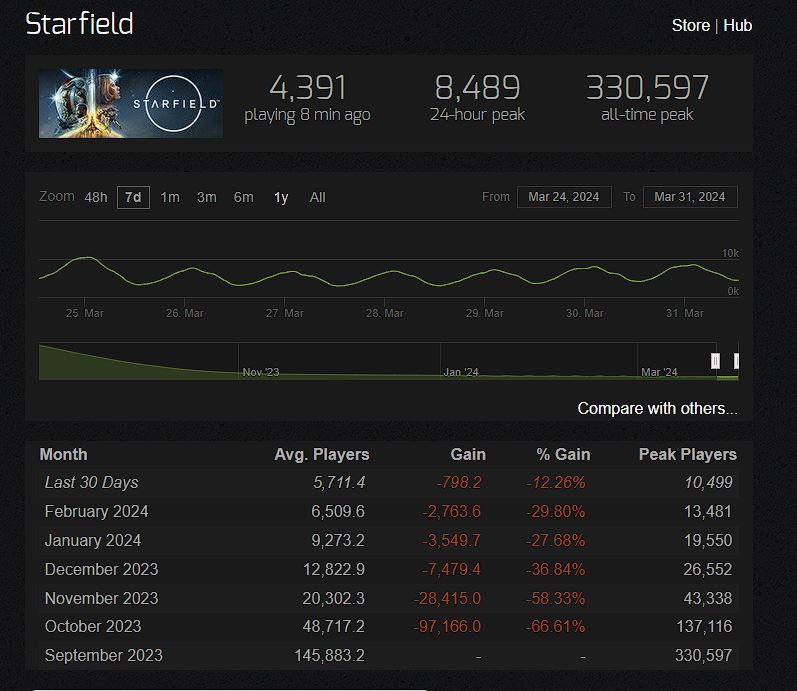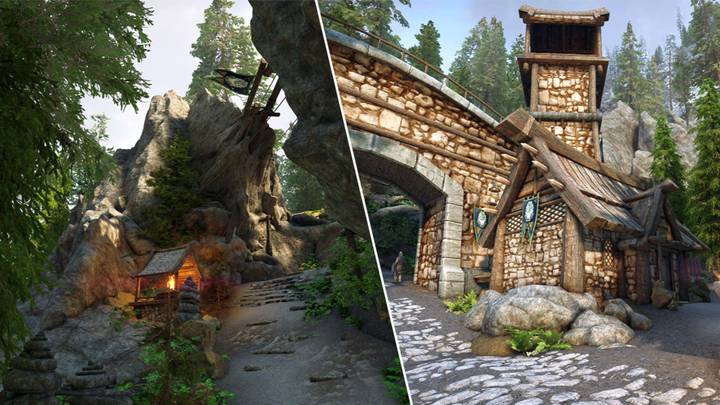Story Highlights
Starfield had a lot of people hyped when Bethesda initially teased it. But after the cosmic dust settled, most gamers came to terms with the fact that the game just wasn’t the expansive universe-spanning title they had hoped it to be. Beyond its rather bland campaign, players really only had the choice of exploring planets, many of which had the same outposts and structures. This could boring really quickly.

As a result, player numbers, despite initially being really high, dropped like crazy. And now, the game has a small fraction of its initial player base. Compared to other titles like Baldur’s Gate 3, which have managed to retain a sizable amount of players even now, it’s clear Starfield was a failure in many regards. If nothing else, it clearly failed to live up to the expectations Bethesda itself had for it. Here are some things they can learn from this.
Design Games To Be Fun, Not Long
In one of the interviews that Todd Howard, director of Starfield, gave close to the game’s release, he mentioned that their goal with Starfield was to aim for longevity. The team saw the title as something that fans could be playing for 10 years into the future. In a way, it’s clear that Bethesda aimed for Starfield to essentially be the new “Skyrim in Space.
Skyrim is a title that has proven the test of time. Even today, the game has an active modding community, that produces great content. Over the years, we’ve seen massive graphical modifications and even entire overhauls that add in new content or recreate some of Bethesda’s other titles within Skyrim’s engine. But one thing has to be made clear: Starfield is not Skyrim.
Whereas Skyrim offered an amazing world, full of engaging systems, Starfield just feels like a hollow shell that lacks any true character. Part of this undeniably comes from the fact that the developers aimed to make this game be played for an unreasonable amount of time. Instead of making a short-but-sweet title that could be enjoyed by players, and experimented on, Bethesda simply went for big numbers.
Comment
byu/PoggersMemesReturns from discussion
inpcgaming
The game has a massive scale, with 1000 planets, and more than 100 star systems. And while all of that sounds interesting on paper, it doesn’t take long to realize none of those large numbers live up to the hype. Very soon into most people’s playthroughs, they are hit with a realization. Most of these planets, even within different star systems, play exactly the same.
And this isn’t a No Man’s Sky situation, where there are tons of systems and additions on top of the base game to keep things interesting. So it’s hard to be excited to explore that 10th planet in Starfield. Knowing what awaits you is basically the same wasteland you’ve been seeing for the past couple of hours of your playthrough. Bethesda, while trying to make this game playable for years, failed to keep it interesting for even a couple of months.
You Can’t Expect Players To Fix Your Game
I can’t help but feel Bethesda relied too much on their player base for this title. Modders have historically played a huge role in giving new life to Bestheda titles. But there’s a reason why fans dedicated so much of their time and energy to making mods for those titles. And that’s the fact those games were simply good in the first place. They didn’t start out bland and boring, and then became playable thanks to the players.

The players made them better, sure, but the base content has to be engaging first. That’s the problem that Bethesda has run into with Starfield. Phil Spencer mentioned the game was designed to be played for more than a decade. Clearly, there was an expectation that fans would continue to pump out free content via mods, to keep things interesting.
But of course, when the base game fails to deliver, no one will spend time on mods. In fact, the modding community for Starfield quickly gave up. This was when they realized the base issues with the game were simply not fixable by them. And even if by some miracle they could be, no one really wanted to work on the game. It wasn’t nearly as engaging or interesting for them to dedicate hours of their life to it.
Above all, it was clear that the fans didn’t want to do Bethesda’s job for the company. It’s not up to the modders to solve the glaring problems and issues with the title. If Bethesda does a No Man’s Sky-esque revival of the title, then maybe the players could give it another chance. But as it is currently, I just don’t see that happening. Especially with the company moving on to other titles like The Elder Scrolls 6.
Underpromise, Overdeliver
Part of the reason why folks were so disappointed by Starfield was the expectations the company had set for it. With it being described as a title that would be played even a decade into the future, it’s no surprise people had their hype set to the maximum. But the fact that what they got in the end wasn’t nearly close to their expectations, their opinion of the game quickly soured.
It’s clear that promising a game as being the next big thing can only lead to disappointment. Fans’ expectations rarely end up meeting with the developers’ intentions. And so, it is best to underpromise, because that way, you have the opportunity of giving the players things they never expected. FromSoftware is the perfect example of how a strategy like this can be successful.
Miyazaki, the director behind the studio, is known for promising less content initially. Before Elden Ring’s release, he mentioned the game’s campaign would be about 30 hours or so long. In reality, your first playthrough of Elden Ring can easily be 100+ hours. Interestingly, people continue to play Elden Ring even nowadays, with new mods, and overhauls being developed by the community. That’s something Bethesda set out for but failed to do with Starfield.
Thanks! Do share your feedback with us. ⚡
How can we make this post better? Your help would be appreciated. ✍



